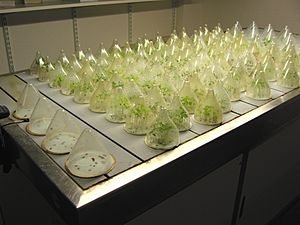Plant physiology facts for kids
Plant physiology is a super interesting part of botany, which is the study of plants. It's all about figuring out how plants work, just like how we study how the human body works. Scientists who study plant physiology learn how plants grow, make new plants, get their food, use sunlight to make energy, and even how they drink water.
Contents
- What Plant Physiologists Study
- How Plants Make Food (Photosynthesis)
- How Plants Breathe (Respiration)
- Plant Nutrition
- Plant Hormones
- How Plants Move (Tropisms and Nastic Movements)
- Plant Clocks (Circadian Rhythms)
- How Plants Deal with Stress
- Seeds and New Life (Germination and Dormancy)
- Plant Pores (Stomata)
- Plant Sweating (Transpiration)
- Related pages
- Images for kids
- See also
What Plant Physiologists Study
Plant physiologists look at many cool things. They study how plants make their own food, how they breathe, and how they get the nutrients they need. They also learn about special chemicals in plants called hormones that help them grow.
How Plants Make Food (Photosynthesis)
One of the most important things plants do is photosynthesis. This is how plants use sunlight, water, and a gas called carbon dioxide to make their own food (sugars). It's like magic, but it's science! This process also releases the oxygen we breathe.
How Plants Breathe (Respiration)
Just like us, plants need to breathe. This process is called respiration. Plants use the food they made during photosynthesis and oxygen to get energy. They use this energy to grow, repair themselves, and do all their plant activities.
Plant Nutrition
Plants need food, but not the kind we eat! They get their nutrients from the soil and air. These nutrients are like vitamins for plants, helping them stay healthy and strong. Things like nitrogen, phosphorus, and potassium are super important.
Plant Hormones
Plants have special chemicals called plant hormones. These hormones act like messengers, telling different parts of the plant what to do. They control how plants grow, when they flower, and even when their leaves fall off.
How Plants Move (Tropisms and Nastic Movements)
Did you know plants can move? They do!
- Tropisms are when plants grow towards or away from something. For example, phototropism is when a plant bends towards light. Roots often grow down into the soil because of gravity.
- Nastic movements are plant movements that don't depend on the direction of the trigger. Think of a Venus flytrap snapping shut or a mimosa plant's leaves folding when you touch them.
Plant Clocks (Circadian Rhythms)
Plants have their own internal clocks, called circadian rhythms. These clocks help them know when to open their flowers, when to grow, and when to prepare for night or day. It's like they have a built-in schedule!
How Plants Deal with Stress
Plants can get stressed too! Things like not enough water, too much heat, or even pollution can stress them out. Plant physiologists study how plants react to these challenges and how they try to survive.
Seeds and New Life (Germination and Dormancy)
When a seed starts to grow into a new plant, it's called germination. Before that, many seeds go through a period of rest called dormancy. This is like a long nap, where the seed waits for the perfect conditions to sprout.
Plant Pores (Stomata)
Plants have tiny pores, mostly on their leaves, called stomata. These stomata are like little mouths that open and close. They let carbon dioxide in for photosynthesis and let oxygen and water vapor out.
Plant Sweating (Transpiration)
When water vapor leaves the plant through the stomata, it's called transpiration. This is like plants sweating! Transpiration helps pull water up from the roots to the rest of the plant, like a giant straw.
Related pages
Images for kids
-
Latex being collected from a tapped rubber tree.
-
Space-filling model of the chlorophyll molecule.
-
Anthocyanin gives these pansies their dark purple pigmentation.
-
A mutation that stops Arabidopsis thaliana responding to auxin causes abnormal growth (right)
-
The poinsettia is a short-day plant, requiring two months of long nights prior to blooming.
-
Phototropism in Arabidopsis thaliana is regulated by blue to UV light.
See also
 In Spanish: Fisiología vegetal para niños
In Spanish: Fisiología vegetal para niños











